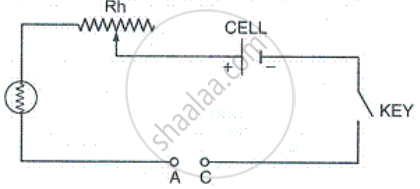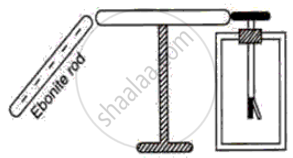Advertisements
Advertisements
प्रश्न
The unit of potential difference is :
पर्याय
ampere
volt
ohm
coulomb
उत्तर
The unit of potential difference is volt
APPEARS IN
संबंधित प्रश्न
(a) Complete the circuit given in Fig. by inserting between the terminals A and C. an ammeter.
(b) In the diagram, mark the polarity at the terminals of ammeter and indicate clearly the direction of flow of current in the circuit when the circuit is complete.
(c) Name and state the purpose of Rh in the circuit.

State and define the S.I. unit of resistance.
Calculate the total number of electrons flowing through a circuit in 20 mins and 40 s, if a current of 40 μA flows through the circuit.
[1 e– = 1.6 × 10-19 C]
Assuming that the charges of an electron is 1.6 × 10-19 coulombs, the number of electrons passing through a section of wire per sec, when the wire carries a current of one ampere is:
The following figure shows a metal rod PQ mounted on an insulated stand. The cap of an uncharged electroscope touches one end Q of the metal rod. A negatively charged ebonite rod is brought near the other end P of the metal rod.

(a) What charge does the end P have?
(b) What charge does the end Q have?
(c) What charge does the cap of the electroscope have?
(d) What charge does the gold leaf have?
(e) Will the leaf diverge or collapse? Give reason.
(f) If the electroscope is now earthed, what charge does the metal rod have?
Label the different parts A, B, C, D, E, and F. State the functions of each part. Show in the diagram the direction of flow of current.
State three factors on which the resistance of a wire depends. Explain, how does the resistance depend on the factors stated by you.
A wire of resistance 1 Ω is stretched to double its length. What will happen to the resistance of the stretched wire?
Compare the brightness of two 60 watt bulbs.
When they are connected in parallel.
Explain giving scientific reasons.
